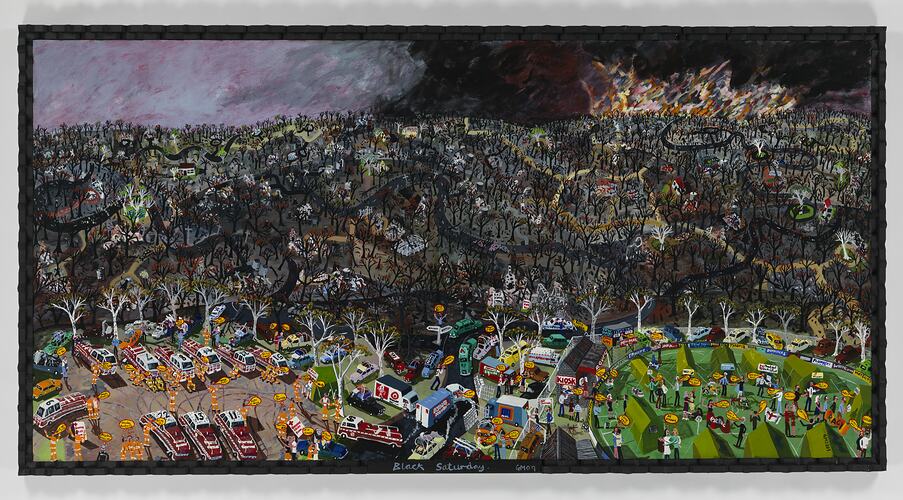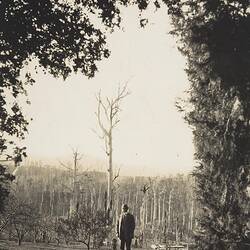Summary
The 'Black Saturday' painting by Glenn Morgan was created after the devastation of Marysville on Black Saturday, 7 February 2009. He had visited Marysville just three weeks prior to 7 February 2009, and had remarked "Jeez, I'd hate to be here if a fire came through".
This is a powerful response to the Black Saturday bushfires. It is a strong and dynamic document of the immediate aftermath of the bushfires. The artwork also draws on his own experience of loss from the Ash Wednesday fires, and the memory of his feelings of 'survival, guilt and why was it us'.
While the work is based on Marysville, Morgan's portrayal of Black Saturday stretches across place and time, and presents the realities of bushfire that have and will continue to shape Victoria's collective memory. This narrative documents a slice of time; it actively depicts the intensity of emotions and the chaos and tragedy of the immediate aftermath of the Black Saturday fires. The artwork is overflowing with stories and the torn fragments of people's lives. It is also a graphic map of the landscape that became the crucible for these catastrophic fires.
The artwork is immensely personal, not just because of its links to Morgan's own experience of trauma and loss, but because each person represented in the work is offering a story of their own lives and trauma. Some of the dialogue depicted includes: "They're all gone", "At least I've got you", "Where's mum?!"
Glenn Morgan wanted the work to 'just tell the story of that time'. Glenn Morgan is a Victorian artist, based in Warrnambool. He has been practicing since 1975 and has been represented in many solo and group exhibitions; his work is represented in regional and national collections. Morgan works with issues and subjects that touch the everyday life of Australians. He uses humour and miniature personal vignettes to 'weave a patchwork of stories'. He is well known for his sculptural installations and models, and also works in oils, acrylic and prints.
Physical Description
Acrylic on plywood, framed.
Significance
This painting renders in stark detail the physical and social impact of the devastating Black Saturday bushfires on Marysville. Drawing on his own experience of the Ash Wednesday fires, Glenn Morgan has depicted not only the wreckage of the town in the aftermath of the fire but also the human consequences of the firestorm. The painting documents a slice of time; it actively depicts the intensity of emotions and the chaos and tragedy of the immediate aftermath of the Black Saturday fires. The artwork is overflowing with stories and the torn fragments of people's lives. It is also a graphic map of the landscape that became the crucible for these catastrophic fires.
While its focus is based on the particular experience of Marysville, the work also documents the complex story of the fires as they impacted communities across Victoria. Morgan's portrayal of Black Saturday stretches across place and time, and presents the realities of bushfire that have shaped and will continue to shape Victoria's collective memory. This is a powerful response to the Black Saturday bushfires, a strong and dynamic document of the immediate aftermath of the bushfires.
More Information
-
Collection Names
-
Collecting Areas
-
Acquisition Information
Purchase
-
Artist
-
Place & Date Depicted
-
Medium
Acrylic
-
Technique
Painting
-
Support
Plywood
-
Primary Inscriptions
Black Saturday GM09
-
Classification
-
Category
-
Discipline
-
Type of item
-
Object Measurements
2525 mm (Width), 80 mm (Depth), 1350 mm (Height)
-
Maximum dimensions
2525 mm (Length), 80 mm (Width), 1350 mm (Height)
Measurement From Conservation.
-
Overall Dimensions
2523 mm (Width), 70 mm (Depth), 1295 mm (Height)
Measured during the Framed Works Conservation Survey (see Event number 1325)
-
Keywords
Art, Ash Wednesday Bushfires, 1983, Black Saturday Bushfires, 2009, Bushfires, Natural Disasters


